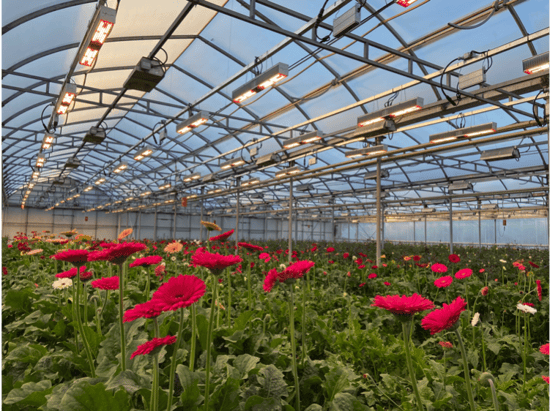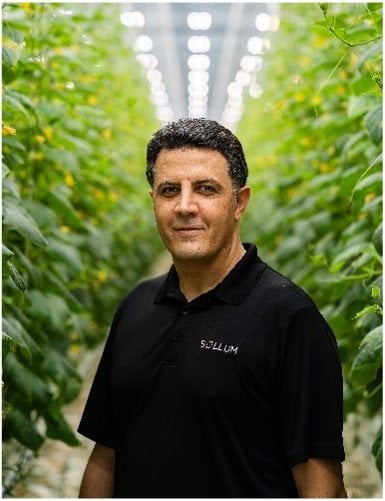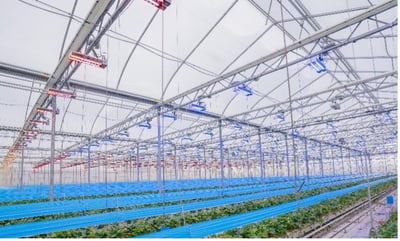Sep 5, 2023
Smart Greenhouse with Dynamic LED Lighting

Image courtesy of Sollum Technologies
Written by: Rose Séguin, Agronomist, Sollum Technologies
September 5, 2023
Horticulture lighting science and technology have significantly advanced since the advent of HPS lighting. LED options are now overtaking HPS lighting in many regions, owing to the improved energy efficiency and advanced controllability of LED lighting, as well as the growing body of research pointing to its benefits. Dynamic LED lighting has emerged in recent years and provides greenhouse growers with unparalleled control over their lighting, and more specifically, over the four following parameters:
-
Zoning-Growers are no longer limited by their electrical installations and can easily create zones based on cultivar, dedicate sections of a greenhouse to trials of new products, section of the greenhouse, etc.
-
Light spectrum-Rather than needing to choose a single spectrum upon purchase and keep it for the fixtures' lifespan, dynamic lighting allows producers to create an unlimited number of recipes, essentially changing the spectrum of any fixture at will.
-
Maximum fixture output-While your lighting system should be sized according to the darkest month of your lighting cycle (in the Northern Hemisphere, December-January), producers might not need to run at 100% intensity during the shoulder months. Adjusting the maximum output can lower light levels during the autumn and spring months.
-
Real-time response to natural light levels-Long gone are the days of the simple ON/OFF control. With real-time dimming based on natural light levels, growers can provide uniform lighting at the head of the crop throughout the entire photoperiod.
With the introduction of adaptable or dynamic LED technology, we can fine-tune the spectrum in ways we could never envision with HPS. Studies show that lighting for different lettuce cultivars enables the grower to improve outcomes for each crop. Understanding these dynamics and how to evaluate these new light solutions is important for greenhouse growers.
Why does it matter?

The light spectrum, also called light quality, is vital for plant growth because the proportion of different wavelengths impacts plant development differently. For example, a high ratio of red-to-blue light promotes leaf growth and stem elongation, whereas a low red-to-blue ratio results in thicker leaves with dark pigmentation. Furthermore, the ratio of red to far-red light can influence flowering in daylength-sensitive crops. The ideal light spectrum for a crop may vary depending on the growth stage and the desired outcome, such as maximizing fruit production or enhancing the color of leaves.
Tailoring light to your cultivars
Finetuning your lighting strategy according to cultivar is essential to greenhouse production, as light responses are notoriously cultivar-specific. For example, some lettuce cultivars grow best with a daily light integral of 16-17 mol/m2/day, while others can handle 20 mol/m2/day. The light spectrum can also affect pigmentation, with yellow and orange bell peppers susceptible to bronzing under high light intensities and high blue levels. On the other hand, these conditions can enhance the leaf coloration in red-leafed lettuce.

Furthermore, dynamic lighting allows growers to create distinct lighting zones to apply optimal lighting conditions for each crop or variety. In a pepper greenhouse, lighting zones can be created for yellow and orange pepper varieties to prevent bronzing. Similarly, a lettuce grower can create zones for red-leafed and green-leafed lettuce varieties according to the optimal DLI and light spectrum.
In vine crop production, growers need to balance vegetative and generative growth. When the plant is out of balance, growers can adjust the zoning, photoperiod, and spectrum to help bring the plants back into balance. This helps ensure the crop's longevity and productivity.
.jpg?width=1180&height=278&name=Untitled+(1180+x+522+px).jpg)
Source: Allegro Acres, Ontario, peppers that grew under Sollum's LED grow light solution.
Unlocking light treatments in your greenhouse
Aside from changing the lighting conditions throughout the season, dynamic lighting also affects crop growth through light treatments. A light treatment is defined as a specific period during which a different day length, spectrum and/or intensity is applied. For example, propagators may apply a long photoperiod and high-blue spectrum during the final days of growth to ensure the customer receives a strong, hardened plant that has not stretched. Alternatively, growers can choose to apply high levels of far-red light during the evening to enhance stem elongation or high blue treatments in the final week of lettuce growth to promote reddening.

Source: Allegro Acres/Sollum Technologies. Sollum light recipe.
Light treatments can also help improve the nutritional quality of crops by stimulating the production of secondary metabolites involved in taste, aroma, and pest/disease resistance. Studies have shown that the light spectrum can significantly impact the concentration of different aromatic compounds in culinary herbs, cannabis, hemp, and other crops. Similarly, studies have delved into multiple crops' susceptibility to pests and diseases and have found that modifying light conditions can indeed increase or decrease a plant's susceptibility to such stresses. These studies all point to a common theme: dynamic lighting can help growers improve crop health from a whole plant level down to the biochemistry in its tissues.

Working side by side, Sollum and The Chef's Garden demonstrated that dynamic LED lighting enhanced the flavor profile of herbs and vegetables.
What to look for in dynamic LED lighting systems
For growers considering a transition to LED lighting and specifically to dynamic LED lighting, the question becomes, "What is the optimal solution for my greenhouse?" The answer depends on the crop, varieties, time of the year, natural lighting conditions, and the production objectives, all of which are subject to change at any point. When evaluating dynamic lighting solutions, consider the following elements:
Level of adaptability

Many LED lighting companies are beginning to use the word "dynamic" without meeting the four criteria for dynamic lighting listed above. When looking for a dynamic lighting solution, look for one that meets these criteria. Opting for a non-dynamic, fixed LED solution may reduce your energy consumption compared to legacy lighting, but you will still find yourself with predefined zones that force you to match your crop to your lighting conditions rather than the other way around. Furthermore, the ability to change your light spectrum at any point allows you to continue providing high light levels to plants while still steering its morphology.
Throughout the lifespan of your lighting system, the industry will only continue to evolve to include new crops and new technologies, and you should feel confident that their lighting system will evolve with them. Truly dynamic LED lighting solutions allow growers to modify their lighting conditions with a few simple clicks, everything from the zones to recipes, photoperiod, dimming settings, and maximum intensity.
Continued support from the lighting provider

For even the most experienced growers, the transition to LED lighting comes with a learning curve. And with all the added benefits of dynamic LED lighting, it is important to be supported by your lighting provider during your transition and afterward. Such support should include a pre-season lighting strategy, regular follow-ups throughout the year and collaboration with the grower to develop lighting trials to continuously improve the lighting strategy over the years. Your lighting solution may only be installed once, but your lighting provider's commitment should last over the system's 50,000+ hour lifespan.
Fixture efficiency and access to rebates
Another important consideration boils down to the capital and operating expenditures, which are critical to calculating your return on investment (ROI). With respect to capital expenditures, it is important to identify the rebate programs in your region, if there are any. Depending on the program's structure, you may be eligible for funding that effectively reduces the purchase price of the fixtures, thus shortening your payback period.
On the operational side, the efficiency of the lighting system determines how much electricity it consumes. While LEDs are roughly twice as efficient as HPS lighting, not all horticultural LEDs are made equal. Look for the photosynthetic photon efficacy (PPE) in the fixture specifications, which is reported in micromoles of light per Joule of input power (umol/J). This value will give you a basic idea of the lighting solution's efficacy, but it isn't the whole picture ― the next step is to look at the dimming capabilities of the system.
With legacy lighting systems (i.e., HPS and metal halide), your lights were either on or off. In this scenario, simply looking at the PPE is sufficient. With LED lighting, growers are now able to use their lighting systems at lower capacity. With dynamic LED lighting, the solution will even dim the lighting system in real-time based on readings of natural light levels. This is especially helpful during the autumn and spring months, when light can fluctuate greatly. Advanced automatic dimming and controls lead to even more energy savings than a simple transition from legacy lighting to non-dynamic LEDs.
What's next in dynamic lighting?

Innovations in horticultural LED lighting combined with fewer financial barriers to installation are making it easier for greenhouses to access this technology. Growers and researchers across the sector recognize that dynamic lighting is the future of horticultural lighting. Main areas of interest are the impact of lighting on greenhouse pests and diseases, improving Brix through light treatments, reduction in the use of PGRs in ornamental production, and enhancing the nutritional quality of fruits, vegetables, and pharmaceutical crops.
On the horizon for dynamic LED lighting is its integration with other greenhouse technologies, allowing growers to respond even more quickly to changes in plant status and maximize photosynthetic efficiency.
Bio
Rose Séguin is an agronomist specializing in controlled environment agriculture, with previous experience in indoor agriculture, agricultural innovation systems, and agricultural development in remote areas of Canada. She holds a bachelor's degree in agro-environmental sciences and a master's degree in bioresource engineering from McGill University, during which she published several peer-reviewed articles and technical reports on controlled environment agriculture and sustainable agriculture. As an agronomist at Sollum Technologies, Rose works with growers to implement dynamic lighting strategies over various greenhouse crops, analyze production data and track progress toward the production targets.
